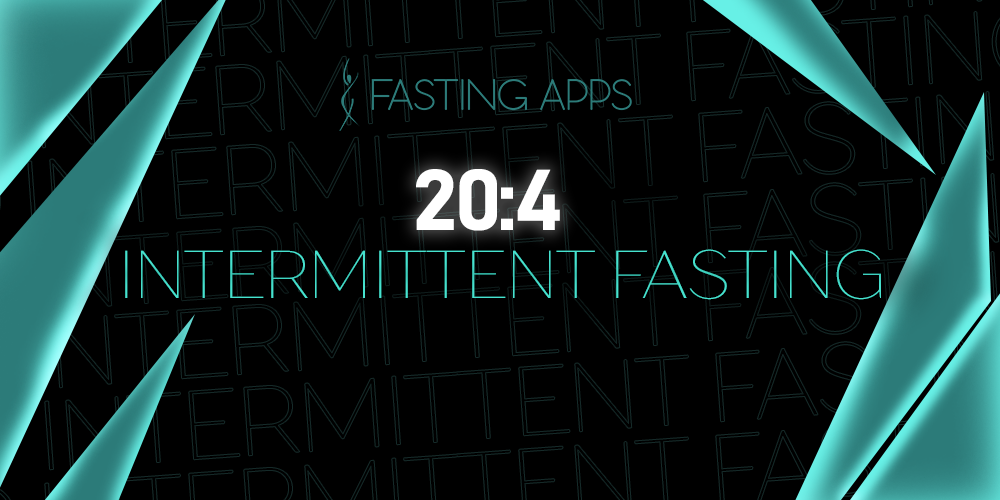20:4 Intermittent Fasting

While this is still an hourly intermittent fasting method, it does start to edge closer to the more demanding forms of intermittent fasting. The 20:4 intermittent fasting method is a form of intermittent fasting that breaks the day into two major segments: 20 hours of fasting and 4 hours of eating. It’s one of the largest fasting windows for a daily plan and should be taken seriously.
Unlike the lesser forms of hourly intermittent fasting, the 20:4 method is designed to strain your body rather than ease its way into weight loss. Though it’s only a 2-hour difference between the 20:4 and the 18:6, the real difference lies in how each fasting method affects the body. With only 4 hours to eat, you must know what you’re going to eat and when.
Let’s take a closer look at one of the most demanding daily intermittent fasting methods out there. If you’re planning on starting the 20:4 intermittent fasting method, you must have a full understanding of what to expect. From the effects on your body to the demanding feeling of hunger you can expect, we’re going to be touching on many of the details that you need to know.
Key Takeaways
- The 20:4 intermittent fasting method is a demanding form of intermittent fasting that requires careful planning for both eating and fasting periods.
- Eating during the 4-hour window requires planning and pacing to avoid overeating or undereating.
- Mentally, the 20-hour fasting period can be challenging, but sticking to it can lead to significant weight loss.
- It’s important to listen to your body and take breaks from the 20:4 plan if needed to maintain overall health and well-being.
- Reverting to less demanding intermittent fasting plans, such as 18:6 or 16:8, can be a helpful backup plan to avoid overstraining the body.
Breaking Down the 20:4
We’ll start by taking a close look at what makes up the 20:4 intermittent fasting method – eating, fasting, and the periods in between. Eating during the 20:4 method can be one of the most difficult parts. When your eating window opens up, you could be tempted to overload yourself with food. Then, by the end of it, you might not have the stamina to eat the remainder of the necessary calories.
Eating during the 20:4 can be quite demanding and requires you to plan in advance. Don’t just improvise your eating during this intermittent fasting method. When your 4-hour window is almost up, it’s important to start winding down. You don’t want to save your biggest caloric intake for the end or else your body will have a tougher time adjusting to the fasting period.
The same idea should be held when your fasting window is almost up. Ease yourself back into eating with smoothies, teas, and gentle foods. Don’t shock your system by introducing tons of fats after going 20-hours with nothing.
Mentally, the 20-hour fasting period can be quite a tough experience. From fending off cravings to dealing with hunger, it can be tough to stick with. However, once you’ve made it a daily routine, the 20:4 becomes one of the greatest lifestyle changes you can make. Sticking with the 20:4 is difficult, but the results are well worth the effort.
Taking Care of Your Body
Because the 20:4 intermittent fasting plan is so demanding, it’s important to make sure you’re listening to and taking care of your body. If you ever start to feel as though the 20:4 intermittent fasting plan is taking a toll on your body, don’t be afraid to take a step back. The whole point of the 20:4 intermittent fasting type is to help you lose weight in a healthy manner. If you’re not healthy, then the whole point of intermittent fasting is lost.
Offer yourself a couple of days throughout the week where you can revert to the 18:6 or the 16:8 intermittent fasting plans. That way, you’re not giving up a day to lose progress, but you’re not putting your body and mind at risk for weight loss.
Backup Plans With the 20:4
As we mentioned, you should feel free to revert to a less demanding intermittent fasting plan. Switch back to the 18:6 or the 16:8 for a couple of days to let your body recuperate. Do not force yourself to stick to a demanding intermittent fasting plan. It will always be there for you to return to.
FAQ
 What is 20:4 Intermittent Fasting?
What is 20:4 Intermittent Fasting?
The 20:4 Intermittent Fasting method is a daily plan that includes 20 hours of fasting and 4 hours of eating.
How effective is 20:4 fasting?
The 20:4 fasting method can be an effective way to lose weight, but it is a demanding method and requires careful planning and listening to your body.
What are 4 hours eating 20 hours fasting?
The 4 hours eating 20 hours fasting plan is a form of Intermittent Fasting that involves fasting for 20 hours and eating during a 4-hour window.
 Is it OK to fast 20 hours every day?
Is it OK to fast 20 hours every day?
Fasting for 20 hours every day can be safe for most healthy people, but it is important to listen to your body and take breaks if needed.
Is a 20:4 fast better than 16 hours?
A 20:4 fast may be more demanding than a 16:8 fast, but it can be more effective for weight loss if done correctly.
 Is a 20-hour fast as good as a 24-hour fast?
Is a 20-hour fast as good as a 24-hour fast?
A 20-hour fast can have many of the same benefits as a 24-hour fast, but the length of the fast may affect the overall results.
 How do you break a 20-hour fast?
How do you break a 20-hour fast?
Breaking a 20-hour fast should be done carefully with gentle foods like smoothies, teas, or fruit to avoid shocking your system.
 What time should I eat on a 20-hour fast?
What time should I eat on a 20-hour fast?
The timing of your 4-hour eating window during a 20-hour fast can vary, but it's important to plan ahead and not save your biggest caloric intake for the end.
 What are the side effects of a 20-hour fast?
What are the side effects of a 20-hour fast?
The side effects of a 20-hour fast can include hunger, fatigue, dizziness, and headaches, but these can be managed with proper planning and listening to your body.
Written By Andrew Brewer
Andrew Brewer started FastingApps to give people the guidance that he never received when he was first starting. His goal is to make your goals achievable and to offer you only the best fasting apps that the internet has to offer. You're not on your own - Andrew and the entire family of reviewers at FastingApps are here with you every step of the way!

 What is 20:4 Intermittent Fasting?
What is 20:4 Intermittent Fasting?